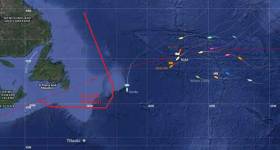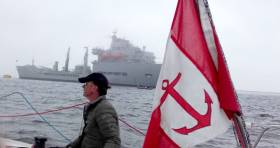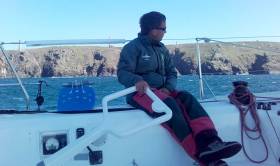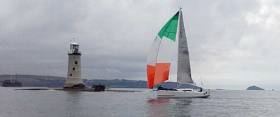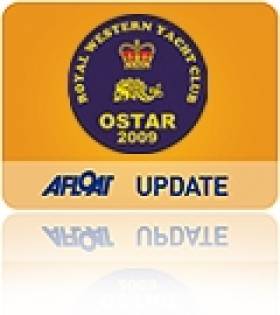Displaying items by tag: Ostar
Conor Fogerty's BAM Team report that the Howth Yacht Club Ostar sailor looks to have had a frustratingly slow night last night despite holding first in the Gipsy Moth division, third in line honours and second in the Ostar line.
Hopefully it was as a result of the eye of the low pressure being wider than expected and not anything else. His local competitors were also slow so probably the former. However, these rules didn't seem to apply to the two-hander Open 40 'Rote 66' who has taken a hefty jump.
BAM is up to speed again on a fast reach and has done a long term job on her sister 'Mister Lucky'. She is way down in the bottom of the low, will have large headwinds and will be feeling the pain of the southern route. Further up the track, 'Vento' the Open 50 has born off to round the Iceberg Limit.
She had been looking like she was going to go through some of the ice but clearly has decided safety first. She has put huge distance on her own race by going so far North. To put the ice in perspective, down on the bottom left you can see Titanic's last position and resting place. Remember, she sank in April, a mere two months earlier than the Ostar schedule.
Tracker here.
Conor Fogerty Makes OSTAR Gains Off The Irish Coast
Conor Fogerty has had a great first 48 hours in his 21–day transatlantic Ostar race. His Jeanneau Sunfast 3600 BAM made a significant play yesterday by heading North to the Irish coast and this has paid off in the short term.
The Open 50 'Vento' was late making this decision and had to turn some sharp corners and consequently lost approx 10 miles to BAM.
The other 3600 'Mister Lucky seems to have adopted a more southerly route and this represents the first large tactical long term split. So, what of the long term? The low out in the Atlantic has moved further North - too far to go over the top of it so this means that there could be significant upwind work which will make it a very tough race. Later today should see winds increase to 20-25 knots, pushing BAM back on to white sails.
Following the OSTAR skipper's Briefing on Saturday 27th, thoughts turned to weather routing and decisions on which of the main routes to take writes John Forde who is supporting solo Irish entry Conor Fogerty in the Jeanneau Sunfast 3600. It was interesting to see the dynamic at play between the competitors, some being extremely guarded and others more happy to discuss plans and share information for this gruelling sea marathon.
Of course besides OSTAR and TWOSTAR race prep, the weekend in Plymouth was dominated by the arrival of Gypsy Moth IV, to her home Port and Yacht Club, The Royal Western. Fifty years ago today or more precisely the 28th May 1967, Sir Francis Chichester arrived back, following the first solo circumnavigation of the globe to an extraordinary reception.
This was commemorated by all the attending skippers with a series of dinners on Saturday and Sunday which simply added to the feeling of history attaching to this pioneering Transatlantic race. Chichester was one of the original founding members of the Race and its first winner in 1960. He took 40 days and 12 hours whereas Conor Fogerty of Howth Yacht Club, 'Captain Fogers' to his friends, amongst other names, all complimentary...is hoping for a circa 21–day crossing.
There was much to do during the day to fully ensure that all the boats were all well prepared as they could be. Sails out and dried, checked re–stowed in order of use or intended use. Winches serviced ,halyards lines and all blocks checked. A full inspection of the rig from aloft and of course the all important Electronic systems on board. The important matter of victualling for the race could not be left to chance. One stalwart English Skipper Neil Payter of Portsmouth has supplies for three months on his Yamaha 33, that's a boat not a bike, to include four cases of red wine! This is some character to meet, hugely entertaining and of course experienced. I should also mention Mervyn Wheatley who according to Conor has a bath on board!! ( He would later arrive at the start line on his Formosa 42 blasting out rousing military tunes, to include the Dambusters at full volume prior to the 10 minute gun). Colourful is the word.
The deadline for work completion was 17.00 each day as the hosting RWYC had thoughtfully arranged all dinners to commence at 18.00 preceeded by a drinks reception.The obvious thinking being this would allow the skippers plenty of time to eat , drink and socialise and still be home in bed by ten to cram as much sleep in, prior to the weeks of sleep deprivation which await.
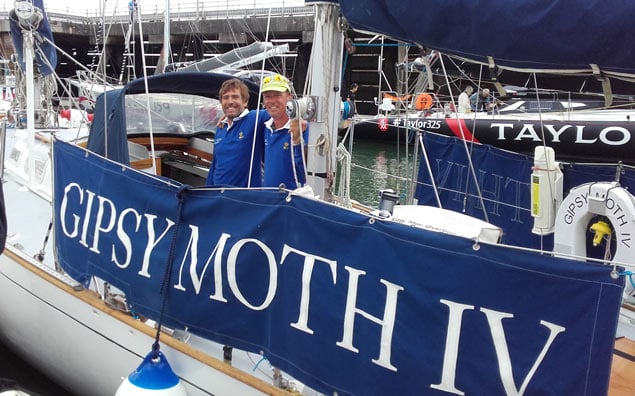 New friends and old on the Gipsy Moth IV
New friends and old on the Gipsy Moth IV
However nobody told the Irish Two, a slew of French, Bretons in the main, and the crew of Gypsy Moth IV who all bonded over good food, wines, Guinness, and some seriously entertaining sing songs. There was no language barrier between the Brits, Irish and French, despite very few of the French having good English and vice versa. 'Bonjour', 'chanson', 'un autre biere' and 'bonne nuit' was as much as we needed, falling back on long forgotten school French like experts, hmmm.
War stories were swapped with past French class winners ,whom had brought a large and raucous fan club. The French along with the British had the most entries with six and five respectfully. Their boats in the main, all heavier older models, tried and trusted. The two Italian entries, the Open 50 Vento di Sardegna of Andrea Mura, the 2013 overall winner, the Class 950 Illumia 12 of Michele Zambelli, and the Portuguese Open 60 Taylor 325 had also come heavily supported.
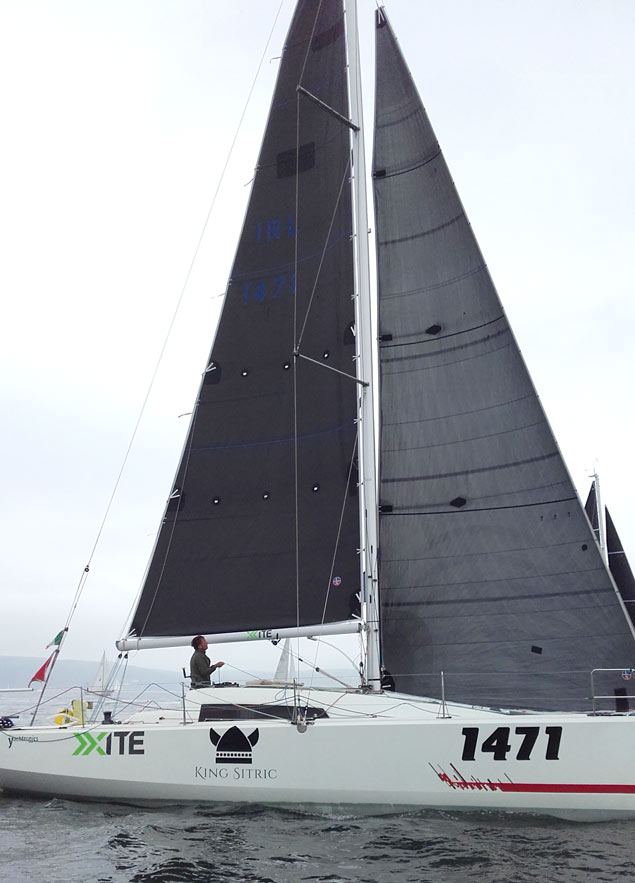 A well known restaurant from Fogerty's home port of Howth adorns the side of the Irish Jeanneau Sunfast 3600 for the transatlantic voyage
A well known restaurant from Fogerty's home port of Howth adorns the side of the Irish Jeanneau Sunfast 3600 for the transatlantic voyage
Whilst the Irish numbers may have been low the spirits most certainly were not. Conor has legions of tales to tell of his sailing adventures having completed two Circumnavigations, once as skipper of the Clipper Cardiff in 2006/2007 series, 31 TransAtlantic crossings and a log which at 350,000 sea miles he stopped personally recording, some years back. However, it is the tales from ashore in all manner of far flung places that are most entertaining. The Gypsy Moth crew which included the lovely Skipper Emily Caruso and First Officer Anna Kastanias Kirton and a slew of nationalities are also tied up with Clipper training and many previous Clipper races and legs. None of their English, Scots, Welsh or American crew however had ventured into the Solo realm unlike our Howth YC hero.
So after a fantastic weekend of hard work and play, to include meeting Tony Bullimore and countless veteran past participants including an 86 year old from the first race of 1960 ... race day arrived , Monday the 29th. Or perhaps we should say we think it arrived, as we were unable to see more than a boat length or two, with dense fog blanketing Plymouth Sound.
The Port was closed, extra time taken over last minute jobs and coffee and a postponment for one hour, until a 13.00 start.
The fog lifted at about 11.00 and Race Office declared boats could head to the start line at 11.30. A large flotilla of all types of floating craft, including yachts, power boats, racing dinghies, RIBs and large jam packed passenger ferries headed out at the same time to a fantastic spectacle , as the sun made an appearance and the wind freshened from the South West. After hoisting the main and tidying away fenders and warps I was struck by the thought that the next time the warps are uncoiled will be in Newport, 3,000 miles away. All going well.
Last farewells to the Skipper before jumping ship into a collecting Rib where up close photos could be taken for sponsors and friends.
We moved to the Committee Boat end which consisted of Royal Naval Supply Vessel, Wave Ruler to await the starting sequence.
Conor had advised he was in no rush to the start giving the marathon nature of the race, particularly given a competitor put himself out of the 2013 race after a start line collision. Ouch.... that could only be described as seriously painful and embarrasing after months of preparation. Watch Conor Fogerty Live at the OSTAR Start HERE!
Of course there were some eager beavers who got to the line early and than had to run down away from the pin and favourable end of the line. Conors Bam came in all the way to the line on starboard , timed beautifully , cutting the line towards the pin not having to ease off. He was closely followed by the Aussie 3600 Mr Lucky, helmed by Mark Hipgrove.
Conor rounded the first mark to starboard, the Eddystone Light in first place although some had him in third. When we first checked YB shortly after the rounding he was first boat on the water, leading the far quicker competitors in the GM / Gpysy Moth, fleet for the highest rated boats.
This must have felt great and a huge confidence boost. Keep up with Conor across the Atlantic via the Tracker here.
![]() Fogerty makes his mark after the first night at sea
Fogerty makes his mark after the first night at sea
This morning Conor had kept up the pace as he had intended, whilst coming down the Channel until clearing Lands End and the Scilly Isles.Yellow Brick had him first in GM class and first in Ostar line honours which is fantastic sailing.
Hopefully this is an omen for the rest of the race and the wind Gods smile down. Latest update sees Bam heading north towards the South Coast of Ireland to catch the fresher breeze.
A weekly satelite call to Cafe East in Howth, Thursday Evenings, time to be announced.
Watch Conor Fogerty Live at the OSTAR Start HERE!
Thanks to modern technology – and more than a bit of assistance from intrepid solo skipper Conor Fogerty himself – Afloat.ie aims to bring you Irish OSTAR entrant Bam! live this morning from the start of the Transatlantic Race off Plymouth.
The Howth Yacht Club solo skipper is already onboard his Jeanneau Sunfast 3600 and the 15–boat fleet is heading out to the start in some very light winds. This has led to the OSTAR race start being postponed for one hour. Watch the live feed from BAM3600 below from 12.50
Fogerty is racing to Newport, Rhode Island a voyage of approximately three weeks. Tracker here
The OSTAR transatlantic race start in Plymouth Sound today at 12:00 BST with Howth's solo sailor Conor Fogerty in the Sun Fast 3600 the sole Irish representative in the international 15–boat line–up. As Afloat.ie reported at the weekend, Forgety arrived safely in Plymouth and is ready for his race across the North Atlantic to Newport, RI, USA that is expected to last three week. See tracker below!
Howth Yacht Club's Conor Fogerty Prepares For Ostar Race 2017
This month sees Conor Fogerty of Howth Yacht Club, preparing for one of the most prestigious and demanding solo ocean races in the international yachting calendar.
The latest instalment of the OSTAR (Original Solo Transatlantic Race), commences on 29th May 2017.
This will see Fogerty, bring his much loved and widely campaigned Sunfast 3600 'Bam', to the start line off Plymouth Sound in the English Channel. This gruelling race which is taxing on both body and mind, heads across the North Atlantic Ocean, to Newport Rhode Island, over 3,000 miles of Ocean.
Although the race name OSTAR may trip easily off the tongue, this generally upwind race, is not for the faint hearted or indeed occasional offshore adventurer.
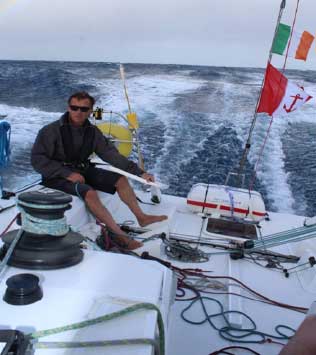 Fogerty and Bam surfing at 20–knots during a 2016 transatlantic crossing
Fogerty and Bam surfing at 20–knots during a 2016 transatlantic crossing
The event sees the solo skippers pit themselves against strong gales and big seas as a matter of course, not to mention, ice, fog, shipping and the occasional whale attack is not unknown.
He will follow in the footsteps of a veritable who’s who of sailing greats and pioneers of ocean racing. The names of Chichester, Knox Johnson, Blyth, Tabarly, Peyron, not forgetting Ellen McArthur are some of those who have sailed this great race before him.
In an Irish context, solo sailor Barry Hurley of the Royal Irish Yacht Club took a class win in the 2009 Ostar after a 21–day match race with an Italian competitor.
OSTAR history can be traced to an English war veteran Blondie Hassler who set about organising the race in 1956 and saw it first run in 1960 under the guidance of The Royal Western Yacht Club. From those early days of sextants and hand bearing compasses, the race has witnessed the trialling of most major innovations in boat design and on board equipment common in modern day sailing. This includes the advent of multi hulls, autopilots, water ballast, GPS, and weather routing. Whilst all of the above have certainly revolutionised sailing for the modern day solo adventurer, they do little to diminish the stark reality of dealing with the conditions, the low pressure systems of the North Atlantic create.
 After 21 days at sea Barry Hurley makes a dawn finish and a class win in the 2009 Ostar
After 21 days at sea Barry Hurley makes a dawn finish and a class win in the 2009 Ostar
Conor is a seasoned campaigner. Last year alone saw his 11–metre Bam start the year with a win in the RORC Caribbean 600. From there a 16–day solo trip to the Azores and then after some much needed R &R in Horta, back to Ireland.
Next up were the ISORA races across the Irish Sea and forays to the South Coast of England and North of France competing in RORC races. Not forgetting a 3rd place finish in the Round Ireland and a Solo Fastnet (SORC) challenge, which but for a fickle wind at the end line, would have seen him claim the top of the podium. The season came down with the Middle Sea Race off Malta which saw Fogerty and Bam claim the 3rd overall in class for the RORC 2016 season.
This was a fitting reward for skipper and crew for the thousands of hard miles campaigning in 2016, without the big budgets of some competitors or indeed sponsorship.
It has been said that the major achievement racing the OSTAR is to get the boat to the start line.
These campaigns do not come easily or cheaply to the racing privateer. The aim now is to get as many sponsors as possible on board, to back this commendable Corinthian challenge.
Conor is in discussions with potential sponsors at the moment, but he also provides a grass route sponsorship option for an individual to have their name displayed on the hull to show support, and to give his attempt every chance of success, and to fly the Irish flag with distinction. If you are interested in providing support, please contact [email protected]
Could Ireland Bid for Solo Race Across the Atlantic?
#ostar – Could Ireland's location be an advantage to any bid to win the rights to stage the the original solo race across the North Atlantic? The next edition of 'The Transat', the original solo race across the North Atlantic that was born as the OSTAR, will start in its historical time slot in May 2016 from the UK to North America but aftet that race the race start location is open to bidders. Is this a new opportunity for Ireland's former Volvo Ocean Race city, Galway to consider?
Start and finish host cities will be invited in January to put their case forward for hosting this event that is both steeped in history, and that helped create a sector of sailing that is now one of the major forces in the professional sport. Traditionally, The Transat has started from the iconic sea-faring port of Plymouth in the UK and finished in the USA. In New York in the first edition in 1960, then Newport, Rhode Island in the intervening years, before Boston became the arrival port in the last two editions in 2004 and 2008.
In 2009, Ireland's Barry Hurley and Italian sailor Luca Zuccoli had an exciting match-race to the OSTAR finish line in Newport, with Barry hugging the shore line (a trick learned from his years sailing in Cork Harbour) and crossing the line literally just minutes ahead after 21 days at sea. The result put him first over the line in his class, and also first on IRC corrected time.
OC Sport renamed the race 'The Transat' in 2004, and added Artemis as Title Partner in 2008, focusing in that year on the IMOCA 60 Class, the boats that compete in the Vendee Globe in the same year. The 2012 edition was deferred at the request of the Class.
With the next edition of The Transat planned for May 2016 in its traditional pre-Vendee Globe slot, consideration is now also being given to the classes that could be invited to compete.
When OC Sport acquired the rights to the race in 2004, it was determined to serve the needs of the professional end of the sport, whilst the Royal Western Yacht Club continued to run a Corinthian race for non-professional sailors restricted to boats of up to 50 feet. The 2004 edition was open to 50ft monohulls and the IMOCA class (60ft monohulls) and the ORMA class (60ft multihulls). In 2008, with the demise of the ORMA class, entry was restricted to the IMOCA class and the Class 40 only. The decision on classes invited to participate will be taken by December 2014.
Dun Laoghaire Announces Debut of Two Handed Fleet for Volvo Regatta
Two handed IRC racing makes its debut in July's Volvo Dun Laoghaire Regatta organisers have confirmed this week. Up to six boats have expressed interest in the new intiative and the organisers say the class will race over a mix of coastal and windward leeward courses. It's an exciting development for the regatta that is already receiving a flow of entries 11 weeks ahead of the entry deadline.
Double handed Class captain Olivier Prouveur of the National YC says boats that have expressed an interest so far are the regular ISORA participant Mojito from the UK, Team Windmill (J109), JBellino (J-122), Dinah (Barry Hurley's modified JOD 35 with which he won his class in the OSTAR 2009) and Oystercatcher (second in the two-handed class in the Round Ireland race).
Other boats are also likely now that the regatta has confirmed the class start, according to Prouveur. The hope of course is others, such as round Ireland winners Psipina Paddy Cronin and John Loden or Alchemiste Michael Murphy and Alex Voye might also be interested.


























